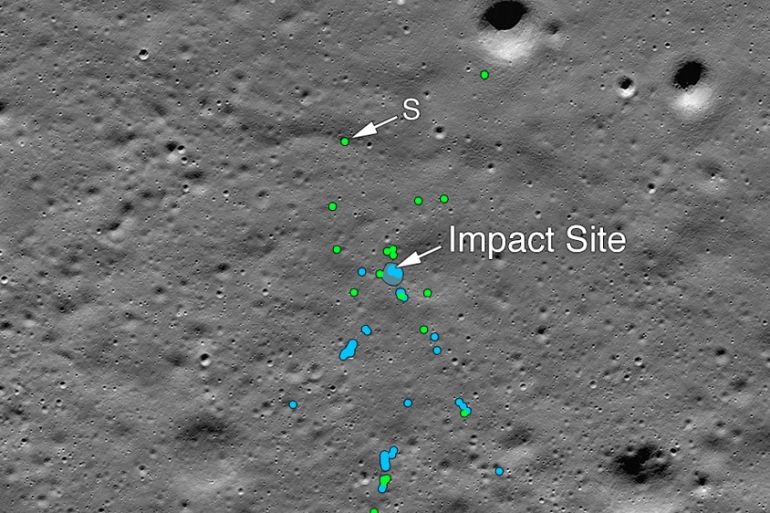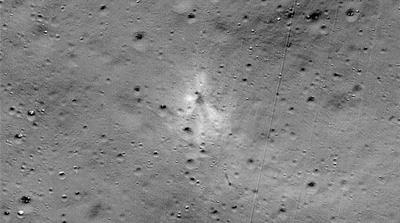In pieces: India’s Vikram Lander found months after it was lost
IT architect in India, whose tip led NASA to lunar lander’s location on the moon, speaks to Al Jazeera.


It takes a special set of eyes and dedication to find what is left of a spacecraft that was originally the size of a minivan, parked some 384,400 kilometres (238,855 miles) away. But after an email tip from an unlikely source and months of scouring images of the moon’s South Pole, NASA confirmed on Monday that India‘s Vikram Lander has been found.
NASA got its first clue from Shanmuga Subramanian, a 33-year-old IT architect in Chennai, India, who told Al Jazeera that after five nights of searching NASA’s lunar images pixel-by-pixel, and with some help from his Twitter followers, he positively identified a piece of the spacecraft.
Keep reading
list of 4 itemsRussia’s Angara A5 rocket blasts off into space after two aborted launches
Photos: Mexico, US, Canada mesmerised by rare total solar eclipse
Moment total solar eclipse occurs in North America
“Though there were a lot of false positives, I found a tiny little dot and compared [it] with previous LRO (NASA Lunar Reconnaissance Orbiter) images up to the last 9 years, which eventually confirmed it would be the debris. Then I reached out [to] NASA,” Subramanian told Al Jazeera.
On September 7, the Indian Space Research Organization’s (ISRO’s) hopes to land a remote-controlled lander and rover on the moon were dashed when it lost contact with the landing craft just as it was meant to touch down on the moon.
Days later, on September 17, NASA’s Lunar Reconnaissance Orbiter, a satellite orbiting the moon, captured images of the landing site and the surrounding area. But despite having acquired the images, the lander’s location remained a mystery.
The Lunar Reconnaissance Orbiter Camera (LROC) team, made up of NASA personnel, scientists and students from Arizona State University, felt that as the sun was setting on the moon, the shadows cast by the craters must have been obscuring the craft and possible fragments.
NASA released the images to the public on September 26. While the exact number of downloads is unknown, according to NASA, the images were studied by many across the globe, including Subramanian.
Just what NASA needed
“His discovery pointed us to the right area … Subsequent searches found the primary impact site and other debris,” John Keller, NASA’s Lunar Reconnaissance Orbiter Mission deputy project scientist, told Al Jazeera.
“His discovery was quite an accomplishment since he was using our first image … when the lighting conditions were poor, and much of the area was obscured by shadows,” he said.
Subramanian said he sent an email about what he thought he saw to NASA on October 18 and again on November 20. The LROC team used Subramanian’s tip to comb through imagery of the surrounding area taken on October 14-15 and November 11, when the South Pole was well lit, and confirmed, without a doubt, that he had found a piece of the Vikram Lander.
Within the debris field, the LROC team has categorised about two-dozen fragments as either “confirmed or likely” pieces of the Vikram lander. On Monday, Subramanian said he received a message from NASA confirming his discovery.
If the landing had been successful, the Chandrayaan-2 mission and its Vikram Lander would have placed India amongst the United States, the former Soviet Union, and China, as a nation capable of a soft moon landing.
In the two weeks after the crash, ISRO failed to regain contact with the lander before the lunar night plunged surface temperatures to -180 degrees Celsius (-292 degrees Fahrenheit). The onboard communications system and scientific instrumentation would not have survived the extreme cold of the moon’s 14 earth-days-long night.
The Vikram Lander and its payload, the Pragyan rover, were the most important aspects of ISRO’s Chandrayaan-2 lunar mission, which was launched in July. The hope was that the instrumentation they carried would have confirmed that the moon had water.
“The crash landing of Vikram made more people interested in it … which lead to me searching NASA’s pictures,” Subramanian said.
“It’s not about where you are from but it’s all about the effort. Anyone can be of great help in space exploration if they put in time and effort in learning about space. And this is not new to me as I have been crazy about rockets right from the scratch.”